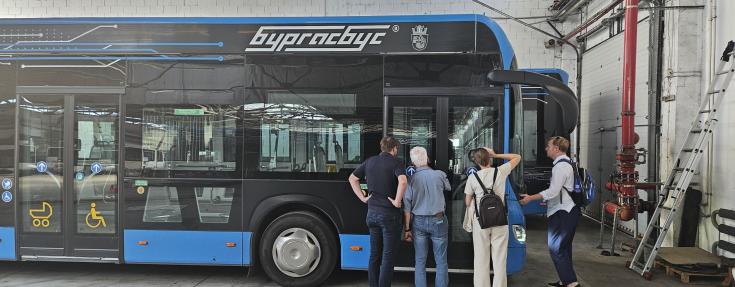GOOD PRACTICE EXCHANGE BETWEEN BURGAS AND GORENJSKA REGION.
On September 24th, 2024, was implemented the first on site best practice exchange within ZCI project. City of Burgas and BurgasBus, Bulgaria hosted a delegation of Slovenian public passenger transport stakeholders and the regional development agency Gorenjska. The objective was to discuss the opportunities and challenges in the process of electrification of cities’ public transport, as Burgas is a good example with the complete transformation of its public transport in a relatively short period of about 10 years.
The company for public passenger transport in Burgas, BurgasBus, together with the city of Burgas in 2013, started to implement the strategy of introducing low-carbon mobility in public passenger transport. 80% of the financial resources for the implementation of the strategy were obtained from European investment projects, while the implementation of the strategy was partly financed also from municipal and national funds and partly from the public passenger transport company’s own funds.
In 2016, a Bus Rapid Transit system (BRT) was implemented in Burgas. The frequency of bus services of BRT is every 5 minutes. Some other lines also have a frequency of every 5 or 12 minutes. The longest frequency is at 20 min. Burgas is providing a night line as well. There are no safety challenges with the night line, as it is mostly used regularly by people who finish or start work at night. The flow of traffic and the speed of bus services are also regulated by smart signaling – traffic lights – in a separate traffic monitoring center.
At the beginning of the mobility transformation of the city, bus fleet was of 150 diesel buses, out of which 56 buses have been replaced with electric buses, 39 with methane buses and 22 with trolleybuses. The company still operates 33 diesel buses, most of which are equipped with EURO 6 standard engines.
Along with electric buses, electric charging stations were purchased. Each bus has its own charging station and parking space. 1MW photovoltaic plant provides electricity for the electric buses. BurgasBus is in the process of placing a storage battery to further optimize the use of solar energy.
All the public traffic is managed by the Traffic centre, which is responsible for following the transport schedule, as well as passengers’ safety.
All buses are equipped with cameras monitoring the road in front of the bus, the driver’s cabin – monitoring the driver’s interaction with passengers and the purchase of tickets, which can be purchased by credit card, debit card or cash. In the passenger part of the bus, the cameras are intended to monitor the movements of passengers and safety. All buses have an adapted entrance for disabled people with a drop-down platform.
Mobile app supports passengers in their trip planning. The application also allows passengers to purchase tickets and validate the ticket with a QR code, as well as interact with the information center.
For 27 years, Burgas is providing on-call door-to-door transportation for the physically challenged people.
From Slovenia, a representative of DUJPP, a representative of ARRIVA Slovenia and two representatives of the Regional Development Agency of Gorenjska took part in the professional exchange of knowledge.
